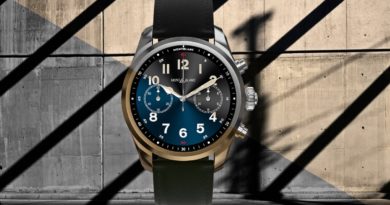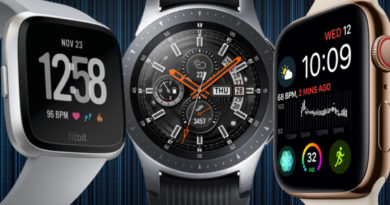Samsung Galaxy Watch vs Gear S3: The key differences between the smartwatches
If you’re looking to buy a Samsung smartwatch, it can be tough to figure out what the real differences are between the Galaxy Watch and the older Gear S3.
Aside from the obvious name change, with Samsung dropping the Gear moniker for the Galaxy tag, the changes are subtle. We’ll be detailing the key design specs below, but both are unmistakably Samsung devices – and, importantly, there’s a distinct style of Samsung smartwatch for women, as well as men.
And naturally, with the company trying to keep up with the competition, there’s also been a big jump in the battery life and exercise support, with a renewed emphasis on standalone connectivity, too.
Full verdict: Samsung Galaxy Watch review | Samsung Gear S3 reviewIs it enough for you to plump for the new generation, or are your needs and price tag better suited to the older Gear S3? Well, below, we’ve given a thorough outline of both smartwatches and the differences between them.
Best Samsung wearable dealsSamsung Galaxy Watch v Gear S3: DesignOverview: The Samsung Galaxy Watch offers a superior smartwatch design over the Gear S3, with a size option better suited to women and waterproofing. It essentially blends together the Gear S3 Frontier and Gear S3 Classic styles to give you a perfect mix, and all the best internal design components are still there. That’s not to say the Gear S3 is far behind, as it still holds up against modern smartwatches, but think of the Galaxy Watch as an evolved version.
Winner: Samsung Galaxy WatchAt first glance, you’d be forgiven for thinking the Galaxy Watch only offers an incremental design tweak over the Gear S3. But, in reality, things have changed enough on this front to make it look and feel different on the wrist.
Sure, it’s not as radical as pivoting to a rectangular face, like the Apple Watch, but with Samsung’s circular, rotating bezel something that continues to impress in the looks department, this isn’t a negative. In the flesh, the Galaxy Watch is really an amalgamation of the two versions of its predecessor, the Gear S3 Frontier and Gear S3 Classic. That means it manages to remain robust-looking while also appealing to the more luxury end of the smartwatch scale – no easy task, of course.
But though the Galaxy Watch doesn’t offer two versions of itself in name, like the S3, it very much does on the spec sheet. Users will have the choice between a 42mm model – ideal for women looking for a Samsung smartwatch – and a more hulking 46mm, the latter of which is the same size as the old flagship. The 42mm device features a 1.2-inch, 360 x 360 Super AMOLED display, weighing 49g and officially clocking in at 41.9 x 45.7 x 12.7mm. Again, that’s slightly different to the 46 x 49 x 13mm, 63g version of the Galaxy Watch, which also packs a 1.3-inch screen of the same 360 x 360 resolution.Read this: Samsung Galaxy Watch 2 rumors and leaksThat’s a stark difference between the new models, with the 46mm only coming in a silver variant and the 42mm – one which we expect will appeal far more to those with smaller wrists – available in rose gold and black. Even if you do have smaller wrists, though, it’s important to be aware that the 46mm Galaxy Watch pulls off the heft slightly more convincingly than the Gear S3, despite the older pair essentially being identical on the spec sheet.
(The Gear S3, above, shares the same rotating bezel as the Galaxy Watch)The Galaxy Watch also has the edge when it comes to waterproofing – a feature which was missed out on the Gear S3. Users will be able to take both variants of the smartwatch under the water up to 50 metres, while Gear S3 owners are only afforded water submersion up to 1.5 metres for 30 minutes and protection from splashes. Essentially, the Gear S3 is not built for swimming, and the Galaxy Watch is.
This gives Galaxy Watch owners the edge in the pool, though, generally, the sensors under the face are the same throughout each smartwatch. Both have versions that offer LTE/4G connectivity, while all have built-in GPS, a heart rate monitor, accelerometer, barometer and gyro for activity tracking and NFC for contactless payments (though MST payment support is only available through the S3, which is a big tick in its favour over the Galaxy Watch if you care about paying from the wrist).
Also read: Samsung Galaxy Watch vs Samsung Galaxy Watch ActiveThe differences are only small on paper, but both sizes of the Galaxy Watch have the edge over the Gear S3 Frontier and Classic. In truth, after the jump from the Gear S2, the S3 gave us a bulky design that never truly sat right with us. After improving things through the Gear Sport last year, Samsung’s new flagship goes a step further – providing a neat option for both small and big wrists with all the functionality and more from the watches that have come before it.
Samsung Galaxy Watch v Gear S3: FeaturesOverview: As with its design, the Galaxy Watch manages to build on what the Gear S3 set up and refine the key aspects. The bigger battery life will be essential for some, and the wellness and exercise improvements help it not only best its predecessor, but also its current rivals in the space. This isn’t to say the Gear S3 isn’t a worthwhile or feature-packed watch in its own right (users prioritising music and solid apps, for example, will still find it very appealing), but it’s without question that the Galaxy Watch wins out in this area.
Winner: Samsung Galaxy WatchDesign is more down to personal preference, but the feature sets of each device can’t be disputed, and it’s often where these battles are won and lost.
Since the Galaxy Watch is two years younger, you’d expect it to have the edge – and it does. The company has made a concerted effort to make its latest smartwatch a truly standalone operation, and that’s made possible by two things: LTE/4G to let you make and take calls, receive notifications and stay connected without your iOS or Android device nearby, and a vastly improved battery life, which can run for up to seven days.
Essential reading: Using a Samsung smartwatch with an iPhoneWith the Gear S3 Frontier featuring LTE, it’s the battery life which is the key difference here. The 46mm version of the Galaxy Watch can run for a week based on light usage, while the 42mm model will muster up around four days, again in low usage. When you factor in GPS, the 46mm Watch should give you 24 hours of continuous GPS battery life and the 42mm Watch serves up around 18 hours.
As we say, this is greatly improved from the Gear S3. It was no slouch, letting you eke out around three days, but things have now progressed to the point far beyond the dark ages of nightly charging.
Add this to the refreshed (though not revamped) Tizen 4.0, and the Galaxy Watch begins to extend its advantage. Samsung’s UI is now even more friendly to navigate, and it holds improvements to both health and activity tracking.
(Left, Galaxy Watch 46mm; right, Galaxy Watch 42mm)This includes better integrated sleep tracking – something Apple itself doesn’t yet offer – to give you insights into your four sleep cycles and total rest, as well as mindfulness features. The on-board heart monitor will continuously take heart rate variability measurements, in order to provide a simplified stress score, with guided breathing modes following on from that to help you relax. It’s nothing too flashy in the wider smartwatch context, but it is new to Samsung smartwatches.
Read this: Best Samsung Galaxy Watch facesSpeaking of new, the Galaxy Watch also debuts a flood of new exercise modes. A total of 39 are available, with 21 of those being fresh indoor workouts – up from the 12 modes that featured on the Gear Sport or the even fewer we had on the S3. All are available through the Health app on the wrist, and, just like the former flagship, automatic exercise detection is also on-board.
However, this feature is slightly more advanced in the new exercise modes, with the Galaxy Watch able to detect if a user is switching between the likes of press-ups, yoga and running in real-time. A total of six different workouts can be automatically chained together into one wider workout.
Something that sees no real advancement is the music streaming, though this is no bad thing. Samsung is still one of the few major smartwatch makers with a dedicated Spotify app, and LTE/4G owners of both the Galaxy Watch and Gear S3 are able to listen on the go and download playlists straight to the watch for offline listening.
It’s a similar story with apps, too. There’s nothing significant available through the Galaxy Watch that you won’t find on the Gear S3, but Tizen’s store has seen steady improvement through the generations and we expect it to continue to provide more and more worthwhile standalone apps for you to take a swing at.
Samsung Galaxy Watch v Gear S3: PriceWith the Galaxy Watch the new kid on the block, it’s only natural that its price point is set to be higher than the Gear S3, which has been out for nearly three years. However, the difference isn’t as great as you might imagine.
The 42mm Galaxy Watch is available for $279.99, while the 46mm version costs $299.99. The LTE/4G version of the 42mm variant comes in at $329.99, and the 46mm will set you back $349.99.
If that’s too much for you to take, you can still pick up the Gear S3 Frontier through Samsung and other retailers for $229.99, with the LTE available for slightly more on retailers such as Amazon.
Samsung Galaxy Watch v Gear S3: Which is best?The Samsung Gear S3 is still a very respectable smartwatch, despite its age, but it does struggle to match up against the more advanced Galaxy Watch in both design and the features available.
Everything that made the old flagship noteworthy – its battery life, connectivity, music streaming and rotating bezel – has been built upon or maintained, while the new smaller edition, wellness features and exercise smarts help cement the Galaxy Watch as the go-to Samsung smartwatch based on our time with the watches.
The differences may not be enough to make this an automatic upgrade for S3 owners, but those looking to pick between the two will get a richer experience through the Galaxy Watch. If you’re not convinced, and the Gear S3 has more than enough functionality for your needs, keep an eye on the price – it’s sure to keep lowering – especially if we see the Samsung Galaxy Watch 2 launch in 2019.


